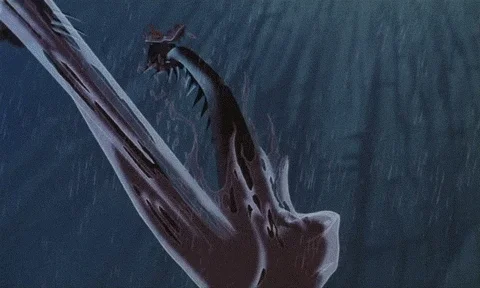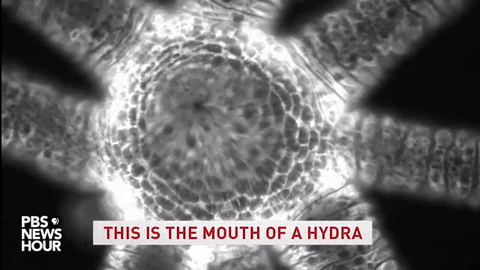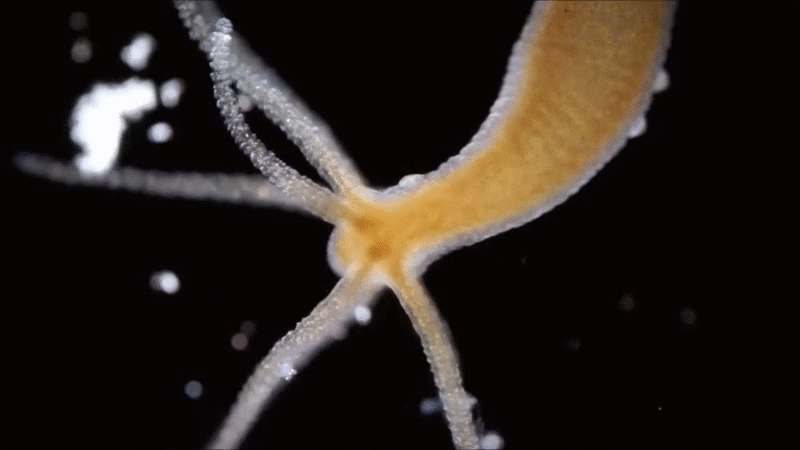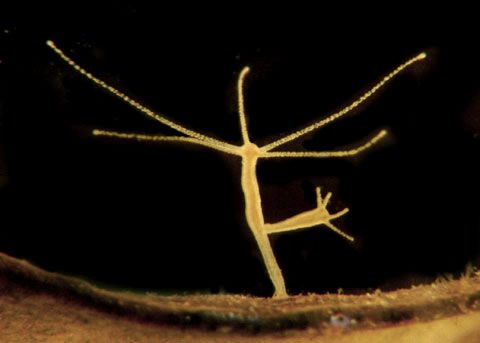«Hydra» es un género que pertenece a los cnidarios (celenterados) formado por animales pequeños de cuerpo cilíndrico y con tentáculos (hidra) que habitan en ríos, arroyos, lagos, pantanos, y son parientes de las medusas, la anémona de mar y los corales.
La hidra es una criatura realmente fascinante, con grandes capacidades como dar volteretas y saltos mortales para moverse, una gran resistencia, y un asombroso poder para regenerarse a tal punto que ¡es considerada un animal inmortal!
Su nombre está asociado a un animal mitológico con forma de serpiente y numerosas cabezas llamado «Hidra de Lerna»
¿Quieres conocer más de este sorprendente animal? Aquí encontrarás todas sus características, dónde habita, qué come, por qué se regenera, ¿es dañina?… ¡No te despegues!
¿Qué es una hidra?
Una «hidra» es un pequeño organismo invertebrado (sin columna vertebral) de cuerpo cilíndrico y varios tentáculos que habita en ambientes de agua dulce (ríos, lagos, lagunas…).
También se le conoce como «pólipo o hidra de agua dulce» porque vive fijo a un sustrato.

¿A qué grupo de animales pertenece la hidra?
Pertenece al filo «Cnidarios» o «Celenterados», por tener células urticantes (cnidocistos) en sus tentáculos y boca, y es pariente de las medusas, la anémona de mar y los corales.
A su vez, forma parte de la clase «Hydrozoa» (del griego hydra, serpiente acuática, y zoo, animal), el orden «Hydroida», la familia «Hydridae», y el género «Hydra», por ser un organismo acuático.
¿Cómo surgió el nombre «Hidra»?
El nombre proviene del parecido que guarda el movimiento de sus tentáculos con las múltiples cabezas de una criatura gigante (en forma de serpiente) de la mitología griega y romana conocida como «Hidra de Lerna»
Cuenta el mito que el animal tenía la virtud de renovar dos cabezas por cada una que le cortaban; de igual forma ¡la hidra puede regenerarse! y dar lugar a un organismo completo a partir de pequeños fragmentos de sus tejidos.

¿Qué características tienen las hidras?
A nivel externo
- Al igual que otros celentéreos, tienen simetría radial (a partir de un eje central, el cuerpo se organiza en partes iguales).
- Su cuerpo adopta la forma de pólipo: un tubo o columna con dos extremos (oral y aboral).
- El extremo oral contiene la boca, rodeada por un ciclo de tentáculos retráctiles (se contraen) que se irradian hacia afuera.
- El extremo aboral cuenta con un pie (pedúnculo) que, en algunas especies está ausente, y una base (disco) para adherirse a diferentes superficies mediante células adhesivas que segregan una sustancia pegajosa.
- Los tentáculos varían en número (entre 6 y 8) y longitud según la especie, y están dotados de células punzantes (nematocistos) que actúan como minúsculos arpones y se activan al mínimo contacto.
- Su tamaño varía entre 2 y 30 milímetros de largo y 1 milímetro de ancho.
- Generalmente son transparentes, de color grisáceo o amarillento, aunque pueden mostrar tonalidades marrón o verde.
A nivel interno
- Está formada por dos capas: epidermis (externa) y gastrodermis (interna), separadas por una capa intermedia o mesoglea, de aspecto gelatinoso.
- El centro del tubo corporal es una especie de saco hueco denominado «cavidad gastrovascular», que se comunica al exterior por la boca.
- No tiene un cerebro reconocible ni músculos verdaderos; los estímulos son captados mediante una red nerviosa primitiva conectada a las células sensoriales que se distribuyen a lo largo del cuerpo, especialmente en los tentáculos.
- Respiran a través de la superficie de su cuerpo (respiración cutánea).
- Los desechos son expulsados por la boca.
- Poseen sexos diferenciados (hembra y macho), con gónadas masculinas (testículos) y femeninas (ovarios) localizadas a lo largo de la región gástrica.
- Ciertas especies son hermafroditas (tienen ambos gametos: femeninos y masculinos).
¿Cómo se clasifican las hidras?
Las hidras se clasifican actualmente en cuatro grupos: Vulgaris, Viridissima, Braueri y Oligactis.
Vulgaris
Es el grupo de las hidras comunes; son de color blanco, marrón o gris, no tienen pedúnculo (pie), el largo del tallo (columna) es mediano y sus tentáculos pueden ser más cortos, de igual tamaño o más largos que la columna, alcanzando hasta el doble de su longitud.
Ejemplares de hidras vulgaris
Hydra americana, hydra japónica, hydra cauliculata, hydra mariana…
Viridissima
Incluye a las hidras que presentan un característico color verde, gracias a la relación de simbiosis (asociación) que mantienen con las algas del género Chlorella; la columna es pequeña, los tentáculos son cortos y no poseen pedúnculo (pie).
Ejemplares de hidras viridissima
Chlorohydra hadleyi, hydra plagiodesmica, hydra sinensis…
Braueri
Incluye hidras de color marrón que no cuentan con pedúnculo (pie); la columna y los tentáculos son cortos.
Ejemplares de hidras braueri
Hydra Braueri, hydra ovata, hydra stellata…
Oligactis
Son hidras de coloración marrón; se encuentran comúnmente en el hemisferio norte y partes de Australia, tienen pedúnculo (pie), y su columna y tentáculos son largos.
Ejemplares de hidras oligactis
Hydra canadensis, hydra robusta, hydra pseudoligactis…
¿Dónde viven las hidras?
Las hidras se encuentran en todos los continentes excepto en la Antártida, así como en islas continentales (Japón, Groenlandia).
Están presentes en todo tipo de hábitats de agua dulce, incluidos ríos de aguas tranquilas, pantanos, arroyos, lagos de agua limpia, estanques… fijadas (por su disco o base) a las hojas de plantas acuáticas, entre las rocas, o en el fondo, adheridas a algún sustrato.
En algunos casos, se adaptan al entorno de los acuarios.
¿Una hidra se puede mover?
Habitualmente, las hidras son inmóviles o sésiles pero, en ocasiones, pueden desprenderse del sustrato y desplazarse lentamente, en especial a la hora de cazar.
Existen diversas formas por los que la hidra puede moverse:
- Al hacer un salto mortal, en el que dobla su cuerpo y se para sobre sus tentáculos para rodar hacia adelante.
- En un bucle, mediante el cual se inclina y adhiere al sustrato con la boca y los tentáculos (parecido al movimiento de una oruga) para luego reubicar la superficie donde se fijará. Es la forma más común.
- Al tirar con fuerza de sus tentáculos.
- Arrastrada por la corriente de agua mientras flota, gracias a una burbuja de gas que crea en su disco.
- Al trepar, uniendo sus tentáculos para adherirse a algún objeto y luego soltarse.
¿Qué tipo de alimentación tiene una hidra?
La hidra es un animal carnívoro, y su dieta incluye invertebrados acuáticos (como daphnia) que flotan en el agua, gusanos de agua dulce y peces pequeños.
¿Sabías que…? En ausencia de presas, una «hydra viridissima» puede sobrevivir durante 3 meses utilizando los nutrientes producidos por las algas que viven en sus tejidos a través de la fotosíntesis. Share on X¿Cómo se alimenta la hidra?
Para atrapar a su presa, la hidra extiende sus tentáculos cargados de toxinas (cnidocistos) a la espera de tener contacto y, al hacerlo, dispara las puntas urticantes y la paraliza.
En ese momento, ¡un grupo especial de células cambian de forma para mostrar una boca!

Luego, la hidra toma a la presa con sus tentáculos, la acerca a su orificio bucal y la succiona para llevarla a la cavidad gástrica donde se absorberán los nutrientes.
Los residuos son desechados por la boca (no tiene poro anal). Al terminar la eliminación de restos, ¡vuelve a sellar la boca con una capa de tejido, y espera a la siguiente presa!
¿Sabías que…? Los científicos han señalado que la hidra es capaz de abrir la boca con diferentes tamaños, que depende de señales nerviosas. Share on X¿Cómo se reproduce la hidra?
Los tipos de reproducción de las hidras son de forma sexual y asexual, y depende de un patrón estacional: en condiciones difíciles (invierno) tiene lugar la reproducción sexual, mientras que, en condiciones favorables, predomina la forma asexual.
Reproducción sexual
Predomina en la época de invierno, en condiciones de baja temperatura y falta de suficientes fuentes de alimento.
El proceso se inicia con la liberación de espermatozoides de un organismo en el agua, que nadan hasta encontrar el ovario de otra para la fertilización del óvulo.
El óvulo fecundado permanece adherido a la madre, y se transforma en una cápsula rodeada por una cubierta protectora dura (embrioteca) que puede ser lisa o tener espinas.
Posteriormente, la cápsula se disuelve y del embrión sale una larva (plánula).
¿Sabías que…? En condiciones desfavorables, el óvulo fecundado de la hidra produce una cubierta protectora y su desarrollo permanece detenido hasta que el medio nuevamente sea el adecuado. Share on XReproducción asexual
Es la forma más común de reproducción de la hidra; ocurre por gemación, un proceso en el que, por divisiones de sus células, surgen brotes o yemas (que varían entre 1 y 6) en la base de la hidra adulta, y representan organismos idénticos a ella en versión miniatura.
El brote recibe sus nutrientes de la hidra progenitora; al terminar su desarrollo, se desprende de ella para convertirse en un organismo independiente.
¿Por qué la hidra se regenera?
Existe un extraño e increíble proceso que le permite a la hidra regenerarse y, a partir de un trozo de ella, ¡reconstruir un nuevo organismo! ¿Cómo sucede?
Resulta que este animal cuenta con una red de fibras de proteína muy resistente llamada «citoesqueleto» que actúa como una memoria queguarda información del cuerpo de la hidra y dirige las células para que se ordenen y den forma a un nuevo cuerpo.
El citoesqueleto es capaz de encontrar un equilibrio entre el mantenimiento de su antigua forma y la adaptación a las nuevas condiciones, y ¡los pasos para que un organismo completo se desarrolle a partir de un pequeño trozo de tejido suceden en solo 4 días!
Por ello es que se dice que son inmortales, pues regenera sus células viejas por nuevas de forma indefinida.

¿Cuántos años puede vivir una hidra?
En condiciones adecuadas para su desarrollo, una hidra ¡puede alcanzar los 1400 años de vida!
¿La hidra es dañina para los humanos?
A pesar de contar con células tóxicas (nematocistos) capaces de inmovilizar y matar a una presa, las hidras no pueden causar daño alguno al ser humano.
En caso de tener contacto con alguna hidra, los síntomas principales que pueden presentarse son irritación o sensación de quemazón, puntos rojos en el área de contacto (petequias) y, en ocasiones, ampollas, náuseas, y calambres musculares.
Como tratamiento, se recomienda lavar la zona con agua de mar, ácido acético o vinagre y, en caso de alguna complicación, visitar al médico especialista.
¿Sabías que…? Entender por completo la capacidad de regeneración de la hidra permitirá a los científicos incorporar esta propiedad en la cura de traumatismos o enfermedades degenerativas en pacientes humanos. Share on XReferencias
Hiroyuki, K., Sungeon, J., Junko, S., Etsuko, A., Jongbin, H., Yoshitaka, Ch., and Taichi, I. (2020). A sleep-like state in Hydra unravels conserved sleep mechanisms during the evolutionary development of the central nervous system. Science Advances. https://doi.org/10.1126/sciadv.abb9415
Olivares, E. (2021). No necesitas el cerebro para poder dormir y este animal lo demostró. Ciencia. https://bit.ly/3tdtLSC

